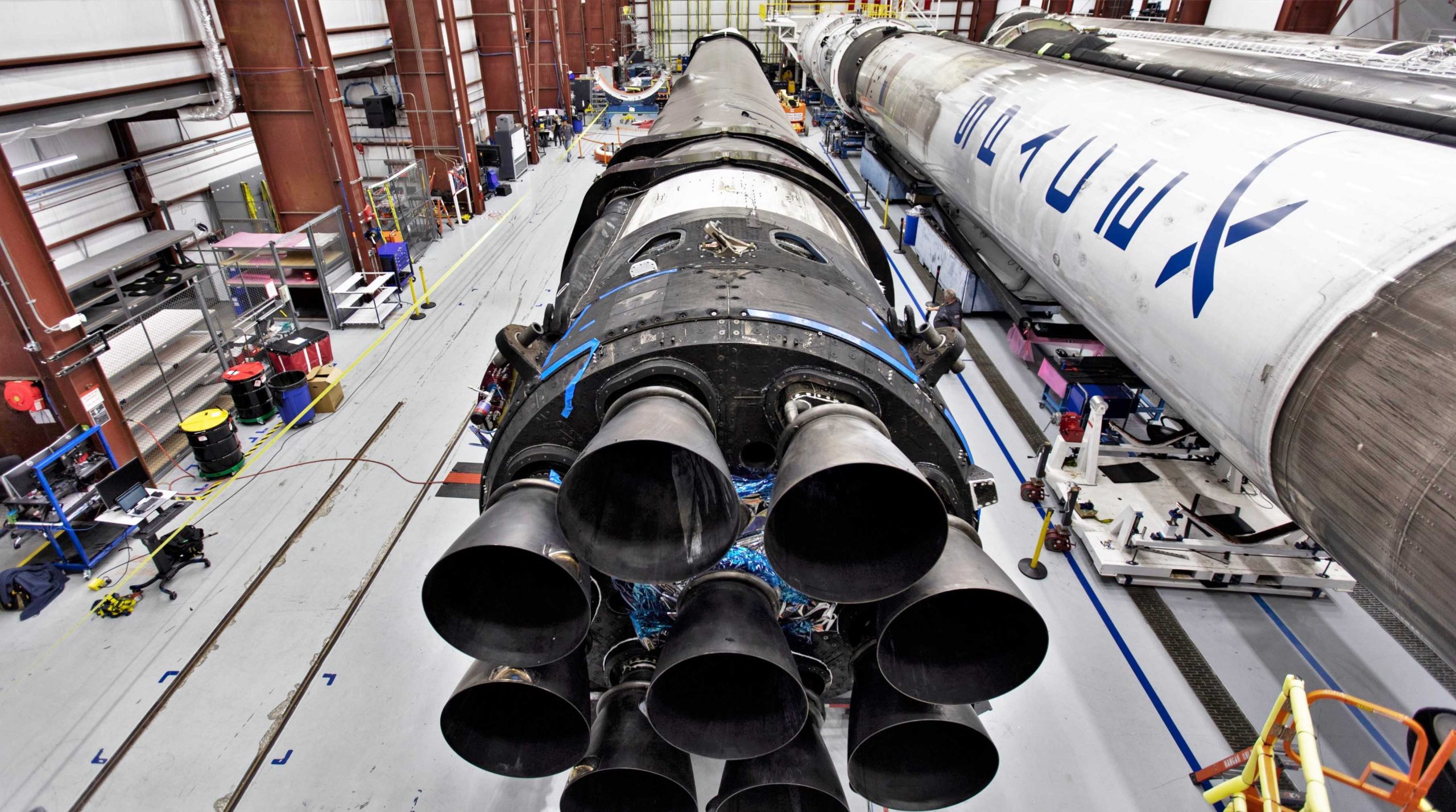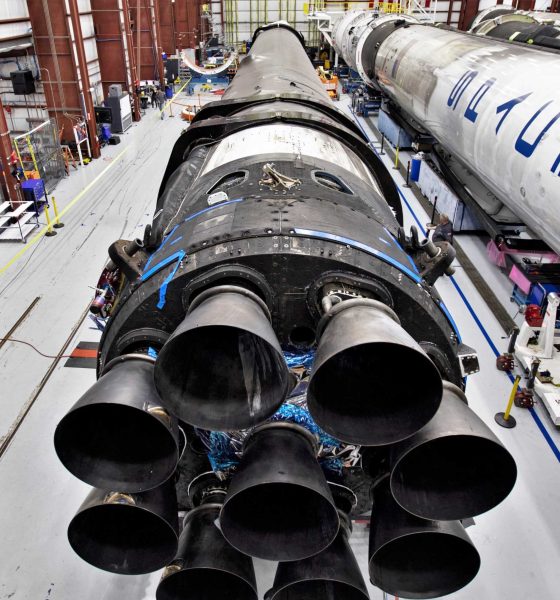

News
SpaceX’s ‘In-Flight Abort’ Crew Dragon capsule and Falcon 9 booster arrive in Florida
Approaching its second month between launches, SpaceX Falcon 9 boosters and their associated payloads continue to arrive in Florida in preparation for what will likely be a burst of several orbital launches in the final months of 2019.
On Tuesday, October 1st, local resident Marcos Hicks (@SpaceCoast_Life) and several other locals captured the latest arrival of a Falcon 9 booster in Cape Canaveral, Florida. This delivery comes just two weeks after Andrew Stoltz – another Space Coast local – lucked upon the arrival of a Falcon 9 payload fairing and one week after Arizona locals spotted a Falcon 9 booster heading East through the state.
On September 24th, an iconic and easily recognizable Falcon 9 booster was spotted heading East through Maricopa, Arizona, an extremely common (if not universal) pass-through point for SpaceX’s cross-country booster shipments. More likely than not, the booster spotted arriving in Cape Canaveral on October 1st is the same SpaceX rocket seen in Arizona one week prior, an indication that the Falcon 9 skipped testing in McGregor, Texas and is thus likely flight-proven.
48 hours later, NASA published photos of the arrival from SpaceX and announced that the rocket is, in fact, the flight-proven booster that will support the Crew Dragon’s critical In-Flight Abort test (IFA). SpaceX employees were still in the process of unwrapping the Falcon 9 booster, but enough of its body was visible to reveal soot, the telltale sign of a flight-proven SpaceX rocket. Impressively, the Crew Dragon that will support the spacecraft’s IFA test also apparently arrived in Florida in recent days.
According to NASASpaceflight.com, B1046 – the first Block 5 booster and first thrice-flown SpaceX rocket – is expected to support the critical Crew Dragon test flight. SpaceX CEO Elon Musk has tweeted several times that there is a “high probability” that the booster will be completely destroyed during the suborbital test flight, a necessary sacrifice to prove that Dragon can escape from a failing rocket at any point during launch. SpaceX has a growing fleet of flight-proven boosters with multiple launches under their belts – B1046 will certainly be missed but its ‘retirement’ will impose no burden on the company’s launch manifest.
As stated in a recent FCC filing, Crew Dragon’s IFA test is scheduled to launch no earlier than (NET) November 23rd. The mission will proceed like any other routine Falcon 9 launch for the first 60 or so seconds, but will feature a “simulated orbital second stage” with a fake Merlin Vacuum engine that will almost certainly be smashed to pieces after Crew Dragon departs the rocket. It’s unclear if SpaceX will physically create failure conditions or if Crew Dragon’s abort will be directly triggered, but the spacecraft will ultimately ignite its SuperDraco abort system to speed half a mile away from the booster in just a few seconds.
This will occur during Max Q, the point during launch when the booster is experiencing maximum aerodynamic and thermal stresses, and Crew Dragon’s departure will essentially smash the rocket headfirst into a wall of supersonic air. The upper stage will likely disintegrate almost immediately, a process that will most likely lead to the destruction of the booster, as well.
Crew Dragon’s onboard launch abort system consists of four “powerpacks” composed of two SuperDracos each, equating to eight SuperDraco thrusters capable of producing up to 570 kN (130,000 lbf) of thrust. SpaceX recently highlighted their confidence in the abort thrusters with a brief video that showed off testing and touted an impressive record of successful static fires and overall reliability.
As Teslarati previously reported, the window for the test launch is expected to open no earlier than (NET) November 23rd. With both the booster and spacecraft now in Cape Canaveral, Florida, it is increasingly likely that SpaceX will be able to complete the IFA test before the end of 2019, a milestone that would increase the odds of SpaceX and NASA attempting Crew Dragon’s astronaut launch debut sometime in early 2020.
Aside from Crew Dragon, SpaceX has plans for as many as four internal Starlink launches between now and the new year, potentially placing as many as 240 more high-performance ‘v1.0’ satellites in orbit. Regardless of the specifics of how the schedule actually shakes out, it looks like SpaceX is working hard to end 2019 with a burst of orbital launch activity.
Check out Teslarati’s newsletters for prompt updates, on-the-ground perspectives, and unique glimpses of SpaceX’s rocket launch and recovery processes.

News
Tesla FSD fleet is nearing 7 billion total miles, including 2.5 billion city miles
As can be seen on Tesla’s official FSD webpage, vehicles equipped with the system have now navigated over 6.99 billion miles.

Tesla’s Full Self-Driving (Supervised) fleet is closing in on almost 7 billion total miles driven, as per data posted by the company on its official FSD webpage.
These figures hint at the massive scale of data fueling Tesla’s rapid FSD improvements, which have been quite notable as of late.
FSD mileage milestones
As can be seen on Tesla’s official FSD webpage, vehicles equipped with the system have now navigated over 6.99 billion miles. Tesla owner and avid FSD tester Whole Mars Catalog also shared a screenshot indicating that from the nearly 7 billion miles traveled by the FSD fleet, more than 2.5 billion miles were driven inside cities.
City miles are particularly valuable for complex urban scenarios like unprotected turns, pedestrian interactions, and traffic lights. This is also the difference-maker for FSD, as only complex solutions, such as Waymo’s self-driving taxis, operate similarly on inner-city streets. And even then, incidents such as the San Francisco blackouts have proven challenging for sensor-rich vehicles like Waymos.
Tesla’s data edge
Tesla has a number of advantages in the autonomous vehicle sector, one of which is the size of its fleet and the number of vehicles training FSD on real-world roads. Tesla’s nearly 7 billion FSD miles then allow the company to roll out updates that make its vehicles behave like they are being driven by experienced drivers, even if they are operating on their own.
So notable are Tesla’s improvements to FSD that NVIDIA Director of Robotics Jim Fan, after experiencing FSD v14, noted that the system is the first AI that passes what he described as a “Physical Turing Test.”
“Despite knowing exactly how robot learning works, I still find it magical watching the steering wheel turn by itself. First it feels surreal, next it becomes routine. Then, like the smartphone, taking it away actively hurts. This is how humanity gets rewired and glued to god-like technologies,” Fan wrote in a post on X.
News
Tesla starts showing how FSD will change lives in Europe
Local officials tested the system on narrow country roads and were impressed by FSD’s smooth, human-like driving, with some calling the service a game-changer for everyday life in areas that are far from urban centers.

Tesla has launched Europe’s first public shuttle service using Full Self-Driving (Supervised) in the rural Eifelkreis Bitburg-Prüm region of Germany, demonstrating how the technology can restore independence and mobility for people who struggle with limited transport options.
Local officials tested the system on narrow country roads and were impressed by FSD’s smooth, human-like driving, with some calling the service a game-changer for everyday life in areas that are far from urban centers.
Officials see real impact on rural residents
Arzfeld Mayor Johannes Kuhl and District Administrator Andreas Kruppert personally tested the Tesla shuttle service. This allowed them to see just how well FSD navigated winding lanes and rural roads confidently. Kruppert said, “Autonomous driving sounds like science fiction to many, but we simply see here that it works totally well in rural regions too.” Kuhl, for his part, also noted that FSD “feels like a very experienced driver.”
The pilot complements the area’s “Citizen Bus” program, which provides on-demand rides for elderly residents who can no longer drive themselves. Tesla Europe shared a video of a demonstration of the service, highlighting how FSD gives people their freedom back, even in places where public transport is not as prevalent.
What the Ministry for Economic Affairs and Transport says
Rhineland-Palatinate’s Minister Daniela Schmitt supported the project, praising the collaboration that made this “first of its kind in Europe” possible. As per the ministry, the rural rollout for the service shows FSD’s potential beyond major cities, and it delivers tangible benefits like grocery runs, doctor visits, and social connections for isolated residents.
“Reliable and flexible mobility is especially vital in rural areas. With the launch of a shuttle service using self-driving vehicles (FSD supervised) by Tesla in the Eifelkreis Bitburg-Prüm, an innovative pilot project is now getting underway that complements local community bus services. It is the first project of its kind in Europe.
“The result is a real gain for rural mobility: greater accessibility, more flexibility and tangible benefits for everyday life. A strong signal for innovation, cooperation and future-oriented mobility beyond urban centers,” the ministry wrote in a LinkedIn post.
News
Tesla China quietly posts Robotaxi-related job listing
Tesla China is currently seeking a Low Voltage Electrical Engineer to work on circuit board design for the company’s autonomous vehicles.

Tesla has posted a new job listing in Shanghai explicitly tied to its Robotaxi program, fueling speculation that the company is preparing to launch its dedicated autonomous ride-hailing service in China.
As noted in the listing, Tesla China is currently seeking a Low Voltage Electrical Engineer to work on circuit board design for the company’s autonomous vehicles.
Robotaxi-specific role
The listing, which was shared on social media platform X by industry watcher @tslaming, suggested that Tesla China is looking to fill the role urgently. The job listing itself specifically mentions that the person hired for the role will be working on the Low Voltage Hardware team, which would design the circuit boards that would serve as the nervous system of the Robotaxi.
Key tasks for the role, as indicated in the job listing, include collaboration with PCB layout, firmware, mechanical, program management, and validation teams, among other responsibilities. The role is based in Shanghai.
China Robotaxi launch
China represents a massive potential market for robotaxis, with its dense urban centers and supportive policies in select cities. Tesla has limited permission to roll out FSD in the country, though despite this, its vehicles have been hailed as among the best in the market when it comes to autonomous features. So far, at least, it appears that China supports Tesla’s FSD and Robotaxi rollout.
This was hinted at in November, when Tesla brought the Cybercab to the 8th China International Import Expo (CIIE) in Shanghai, marking the first time that the autonomous two-seater was brought to the Asia-Pacific region. The vehicle, despite not having a release date in China, received a significant amount of interest among the event’s attendees.








